America's black babies are paying for society's ills. What will we do to fix it?
This project received support from the Center for Health Journalism's California Fellowship and its Fund for Journalism on Child Well-being.
Other stories in the series include:
Black babies die at twice the rate of white babies. My family is part of this statistic
Why are black babies twice as likely to die as white babies in the US?
Saving black babies by saving a whole neighborhood
What's behind the high black infant mortality rates? Racism, not race
Empowering moms – and dads – in the black infant mortality crisis
Moving from talk to action on black infant mortality plan
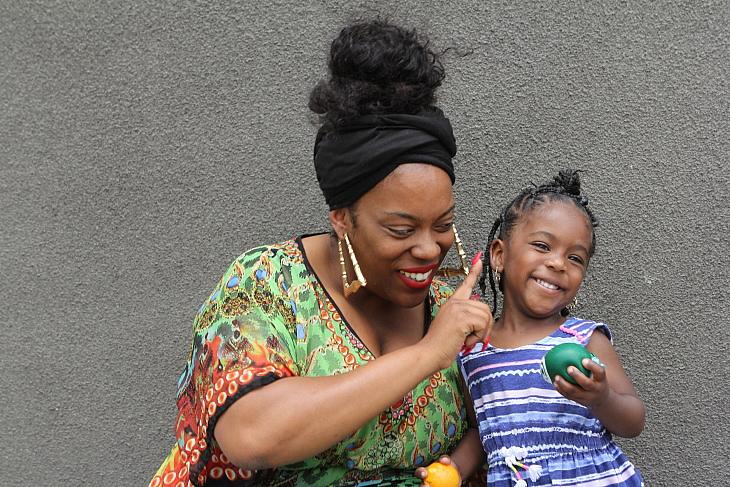
Raena Granberry and her 2-year-old daughter Justice. Granberry lost a child who was born premature. She now works to educate black women of the risks. (Priska Neely/KPCC)
Black babies in the United States are far less likely than white babies to reach life's simplest milestones: to form words, to learn to crawl, to take their first steps.
That's because black babies born in America are two times more likely to die before their first birthday than white babies. The numbers are even worse in Los Angeles, where black babies are three times more likely than white babies to die in their first year of life. Nationwide that means more than 4,000 black babies are lost each year.
Powerful articles, as well as stories from celebrities like tennis star Serena Williams, have been a stark reminder that even the most wealthy and healthy black women and their babies are vulnerable.
The truth is that the gap in mortality rates between black and white babies has existed for decades. And it has not budged.
Why? It turns out the answer to that question makes a lot of people uncomfortable.
And that's one of the reasons black babies continue to die at such higher rates, according to those who have studied the problem.
FAILURE TO CLOSE THE BLACK-WHITE GAP
I'd been working on this story for months when I stumbled on a transcript of a Congressional hearing held way back in 1984. I was doing research in the bowels of the the public library in downtown Los Angeles. The title jumped out at me: "Infant mortality rates: failure to close the black-white gap."
I was pretty new to the topic, even though I realized the problem had touched my own family. To see that report on the library shelf - more than three decades old - underscored what I'd been trying to understand: Why was such a major problem still unknown to so many? Still unsolved?
I started reading.
Lawmakers then thought the gap in mortality rates between black and white infants was at such crisis levels that they called that hearing at the urging of the Congressional Black Caucus.
Here's what the late congressman Julian Dixon, who represented L.A., said:
"Research and experience has proven that America has the tools to stop the needless deaths of poor infants. This is why we believe the present level of black infant mortality is unacceptable."
But knowing there was a crisis and solving it are two different things. And at the time, no one understood exactly why the gap existed.
Edward Brandt, an assistant secretary in the Department of Health and Human Services, summed up the dilemma:
"If you take a group of comparable black women and white women who are college-educated, married, receiving total prenatal care from the first trimester all the way through, the rate of infant mortality is still twice as high in black women," he said.
Graph presented during 1984 Congressional hearing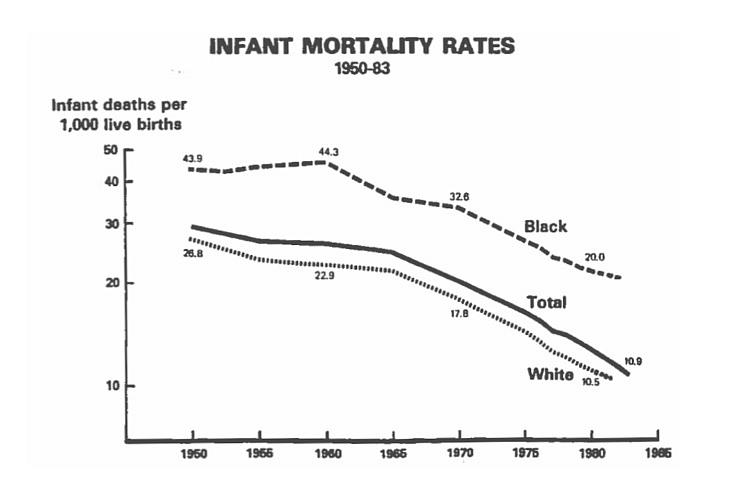
"I am not convinced that we can reduce it to the white rate with the current state of our knowledge, because I don't know what the rest of the problem is."
Dr. Vicki Alexander was at that hearing. When she heard those words, she was "disturbed and angry."
It seemed to her that authorities were effectively throwing their hands in the air.
Alexander, an obstetrician and gynecologist, had seen many mothers grieve babies who died, some born too early or too small to survive. When her time came to testify she went off-script.
"How can Mr. Brandt say to her, 'We don't know what caused your baby to have low birth weight? We don't know why your baby died and so therefore we can't allocate enough funds to pay for any improvement?' " Alexander questioned.
She voiced her frustrations about the lack of action at the federal level. She called it a "genocide through neglect perpetuated by the U.S. government."
At the end of Alexander's testimony, she asked these questions:
"How long is it going to take to change it? Why should black babies die twice as frequently as white babies? How many bedsides am I going to have to sit at constantly over and over, and how many times are we going to have to take time away from that patient and come here to Washington, D.C. to say it over and over again?"
SEEKING ANSWERS
At almost every age and parity combination, blacks are twice as likely as whites to have a low birth weight infant. Similarly, educational attainment explains only a small portion of the black/white differential. Even births to black mothers with college education had a higher low birth weight incidence than births to white mothers with less than a high school education. ... Thus there is still a great deal we need to learn about the reasons for the black-white disparity in pregnancy outcome. - Joel C. Kleinman, director for analysis, National Center for Health Statistics, 1984
Policymakers have taken a variety of approaches to address the gap in infant mortality over the decades. They've blamed mothers for lifestyle choices. They've questioned whether genetics explains the problem.
But here's the consensus today, some 34 years after that Congressional hearing where a top health official said he had no answers:
The cause is a social one, and the suspected assailant is chronic stress brought on by being a black woman in this country.
The focus now? Structural and institutional racism. Researchers, policymakers and practitioners are examining the social determinants of health to explain the stark difference in mortality rates. They've considered how racism manifests itself in the health care system, in social and physical environments, in access to education and treatment in the workplace.
But it's one thing to identify the complex social cause of a concrete public health crisis; it's another to figure out how to unravel that deep social problem in order to stop more babies from dying.
Infant mortality overall has dropped with advances in medicine, prenatal care and our ability to keep preemies alive. But today, the United States still ranks higher than dozens of other developed countries in its overall infant mortality rate - and experts say addressing the racial disparities is key to bringing it down.
The persistence of these ugly statistics seems to be intertwined with the complex nature of the issue. More and more research points to the idea that solving the problem of black infant mortality will require deep changes to American society. And across the country, communities are trying, in big ways and small, to do just that.
In some parts of the country, educators and policymakers are working to empower whole neighborhoods to improve the lives of all who live there with an eye to saving the littlest residents. In other areas, grassroots organizations are breaking the problem down into its component parts to chip away at the issue where they can.
And in Los Angeles County, public health officials are launching a plan that aims to do a hybrid - both raising awareness and improving lives for black women by mitigating the chronic stress that contributes to the problem.
'I WOULD HAVE THREE CHILDREN AND NOT TWO'
"I ask you, do these obscenely high figures bear any resemblance to success? We have failed as a nation to improve the survival rate of our most precious resource - our infants." Congressman Ronald Dellums, 1984
When Raena Granberry lost her son in 2011, she, like many black women, was in the dark that her personal loss was a piece of a national crisis.
"It wasn't until it happened to me that people in my family started coming out the woodwork," she said.
Aunts, cousins, friends shared that it had happened to them, too.
Raena Granberry lost her first baby, a boy, in 2011. (Priska Neely)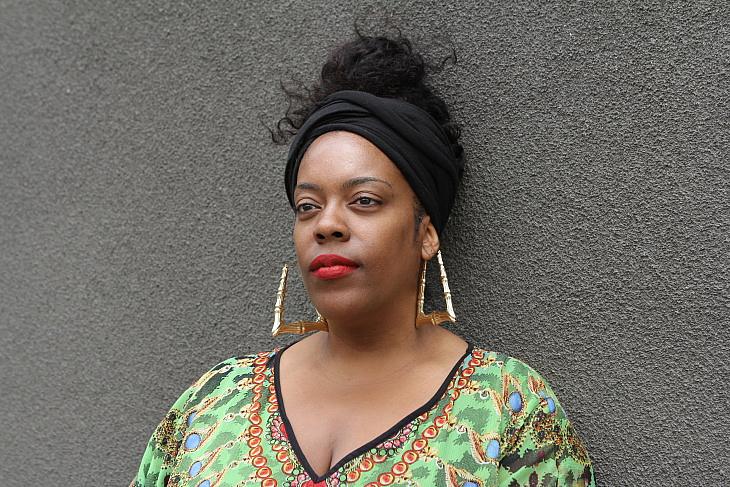
It's bigger than her. It's bigger than her family. In Los Angeles County, where she lives, the gap is wider than the national rate - black babies are three times more likely to die in their first year of life. In 2016, out of the more than 22,808 white babies born, 73 died. Out of the more than 8,000 black babies born, 88 died, according to the latest available data from the county.
Most of the babies, like Granberry's son, die because they are born too early, too small. Between 2013-2015, 13 percent of black infants nationwide and 12 percent in L.A. County were born premature.
Granberry was 28 when she got pregnant. A college graduate, with a supportive partner and a job, she looked for a "five star" hospital outside of her neighborhood.
But she did not get high-quality care.
"I never spent more than 5, 10 minutes with the same doctor," she said.
For weeks, she told her doctors about the spotting and pain she was experiencing and she was told not to worry.
"I consistently knew all through my pregnancy that I was not fine," said Granberry.
Raena Granberry handing out flyers about the Black Infant Health program at a Black Independence Day event. She goes anywhere from nail salons to doctors offices to do outreach. (Priska Neely/KPCC)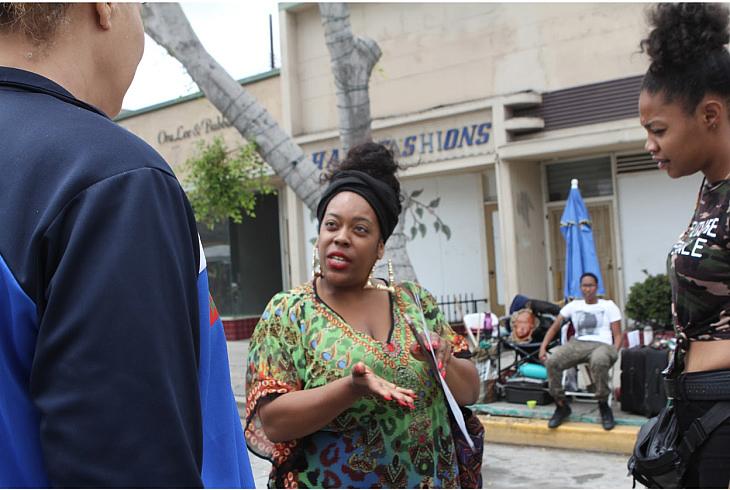
Many studies have shown that black mothers often aren't taken seriously or treated for pain, which also contributes to the alarmingly high maternal death rate. Raena went into labor just six months into the pregnancy.
"The physical act of pushing out the baby and hearing no tears, having no baby to keep, ended up being way more traumatic than I thought it would be," she said.
Granberry is used to talking about this traumatic event.
After losing her child and realizing the broader public health issue, Granberry started doing community outreach for an Inglewood group called Great Beginnings for Black Babies.
"I made that my mission to be very open about what I went through so that I could let people know that they weren't alone," she said.
As part of that work, she recruits women to the state-funded Black Infant Health program. It was created in 1989 to address the high black infant mortality rates in the 15 most-affected jurisdictions around the state. Great Beginnings was one of the first administrators of the program.
Before Granberry worked for the group, she came there as a client in 2013 during her second pregnancy. Through a series of classes, she made connections with other black moms and learned about the data. She also heard about the role played by the chronic stress of living as a black woman in America.
RACISM NOT RACE
The fact is that, in my district, Houston, with one of the most affluent communities and also one of the best, if not the best, medical center, black women are still suffering from delivering high-risk babies. ... It bothers me and - I guess it is a question of priorities. - Congressman Mickey Leland, 1984
Paula Braveman, director of the Center on Social Disparities in Health at the University of California, San Francisco, is well aware of what many people think when they hear black infant mortality is so high.
"The assumption they leap to is that this must be the women's fault, it must be bad behaviors," she said. "They don't eat right, they don't exercise enough, they smoke, they drink, even though the fact is that African Americans smoke less than white women."
And there are things individual moms can do -- seek prenatal care early, maintain a healthy diet. There are things that can be done in the clinical setting. Doctors recommend low-dose aspirin for women at risk for preeclampsia and some prescribe hormonal progesterone shots to prevent repeated preterm births.
But Braveman and other health experts say the gap does not come down to people's behavior. That's because such steps alone cannot resolve the outside forces that influence black women as they move through the world. And that's hard for some people to hear.
"The concept of institutional racism or structural racism are things that people find very difficult to understand because they hear racism they think: 'I'm not a racist,' you know, therefore this is talking about some other bad individuals," said Dr. Tony Iton, senior vice president for healthy communities at the California Endowment.
"The issue with racism and how it impacts black infant mortality is really much more about structural and institutional and essentially how whole communities are treated or steered away from resources and opportunity, and less, per se, about how individuals are acting, although there is an element of that as well."
Here's how that plays out in everyday life. In the 1970s, Arline Geronimus was working with pregnant teens. She noticed that it was not the young teens who seemed to have higher risks, but rather it was the black women who waited to get pregnant. She coined the term "weathering"to describe how social and environmental factors can cause chronic stress that leads to a deterioration of health as black women age.
Her research faced extreme criticism and was dismissed at first. But now it's been replicated and validated.
While some researchers were focused on finding a genetic explanation for the gap, Chicago-based neonatologists Richard David and James Collins theorized that the disparities in birth outcomes were a result of racism, not race.
In 1997, David and Collins further debunked the genetic explanation. Their study found African-born black women who moved to the U.S. had similar birth outcomes to American-born white women.
Tyan Parker Dominguez, clinical associate professor of social work at the University of Southern California, said those findings point to "something about the social environment in which African American women live that is detrimental to their health."
Parker Dominguez has researched how experiences with racism -- from overt discrimination during childhood to structural racism that leaves neighborhoods impoverished -- act as a psycho-social stressor. Such stressors, she found, can erode the body and lead to preterm delivery and increased susceptibility to disease.
Raena Granberry with her 2-year-old daughter Justice and 5-year-old son Judah, who was also born premature. (Priska Neely/KPCC)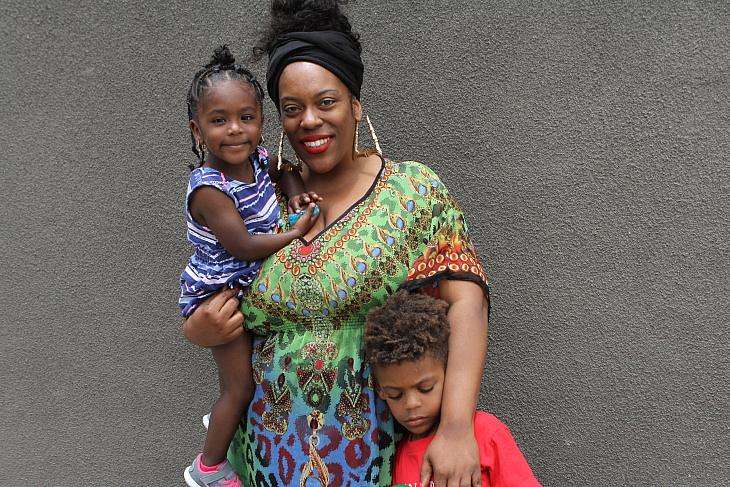
Think of it this way: Some black women, she said, are "maintaining the sense of vigilance knowing that there's this constant potential threat in your environment, simply because of what you look like."
"You have to be aware of that and be prepared for that every time you walk out your door. And that's chronic. That chronic sort of threat can be related to a physiological hypervigilance so that your body's stress response system remains chronically engaged."
Raena Granberry had experiences like this in her life, but it wasn't until the classes she took through the Black Infant Health program that she learned how the strikes against her could affect her children.
"[Systemic racism] seems like a big monster that attacks every part of my life," said Granberry. "It attacks me as a pregnant black woman, as black mother, as a renter, as a person trying to maintain a healthy diet. Racism hits me in all of these areas. It's very overwhelming."
Empowered to advocate for herself in the doctor's office, she and her husband went on to have two other children, now ages 2 and 5.
"If I had had any of this information, I would I have done so many things differently, and I would have three children and not two."
SAVING BABIES BY SAVING A NEIGHBORHOOD
Single-focused approaches may not realize the significant reduction in the black-white gap we all hope to achieve. Reducing infant mortality is a national problem that requires the efforts of all members of our society for solution." - Edward N. Brandt, Jr. Assistant Secretary for Health, Department of Health and Human Services, 1984
Flipping past a slide with diagram of the stages of labor, Sandra Tramiel stands before a dozen expecting mothers and offers them some frank advice about a dilemma that might crop up as they give birth.
"POOP!" she said to uncomfortable squirms and a few chuckles. "The baby's head is right there on the rectum. There's no way around it. If you do have to, let it go."
Tramiel, a retired public health nurse for the Alameda County Public Health Department, is leading a pregnancy basics workshop that's combined with a baby shower. The hope is to connect the moms who come with other services the county offers, like home visitation programs that can help them with breastfeeding and other parenting skills.
She goes over what to expect in different trimesters, how to tell if their contractions are really regular, and what their birthing partner can do to help in the delivery room.
The goal is to give them the freedom to ask questions, information to empower themselves in the doctor's office, and an opportunity to build connections with other moms.
Sandra Tramiel take a photo of one of the expecting mothers attending the combination birthing class and baby shower. (Priska Neely/KPCC)
"My hope also is that they have better communication with their support partners, and that they can look forward to the birth of their baby with open eyes," said Tramiel.
This is one of several activities taking place in the Castlemont neighborhood of East Oakland during the May Annual Market.
There's also a boot camp for dads at the community center. A family playtime event takes place on the blacktop outside. Children squeal in a bounce house and moms do their best to match the steps of a Zumba instructor. Local vendors line a walkway selling t-shirts and jewelry.
This market is a visible manifestation of the neighborhood's designation as a "Best Babies Zone" or a BBZ.
It's based on a health care concept called the "life-course approach." The idea? Reducing black infant mortality and closing the gap in birth outcomes requires quality health care across a lifespan. It also requires other support, both at the family and community level, to influence the health of black women and address social and economic inequities that underlie health disparities.
"We have a hard time really understanding how the past is connected to what's going on today," said Rebecca Reno, part of the national team that supports BBZ at the University of California, Berkeley School of Public Health.
Reno said the key to the BBZ approach is recognizing "this is not a simple issue and this is not something that one single initiative alone is going to address. It's really rooted in all of these historic injustices."
Castlemont was part of the first cohort of neighborhoods to join the initiative in 2012. In Alameda County, where Castlemont sits, the infant mortality for black babies is 4.3 times higher than the rate for white babies, based on the latest available numbers in 2016.
There are eight other Best Babies Zones across the country, in neighborhoods in New Orleans, Cincinnati, Indianapolis, Cleveland, Milwaukee, as well as Portland, Oregon, and Kalamazoo, Michigan.
Each uses a community-driven approach with local organizations taking the reins on the ground. In New Orleans' Hollygrove community, residents are fighting a proposal to route a train through their neighborhood. The BBZ team there collected soil and air samples to show the harm that the train would have to the community's health.
In East Oakland's Castlemont neighborhood, a 12 x 7 block area, the market was created to address a broken local economy. It's also a space that creates opportunities for families to connect.
Oakland resident Cassandra Hughes works for Room to Bloom and also sells her jewelry at the market. (Priska Neely/KPCC)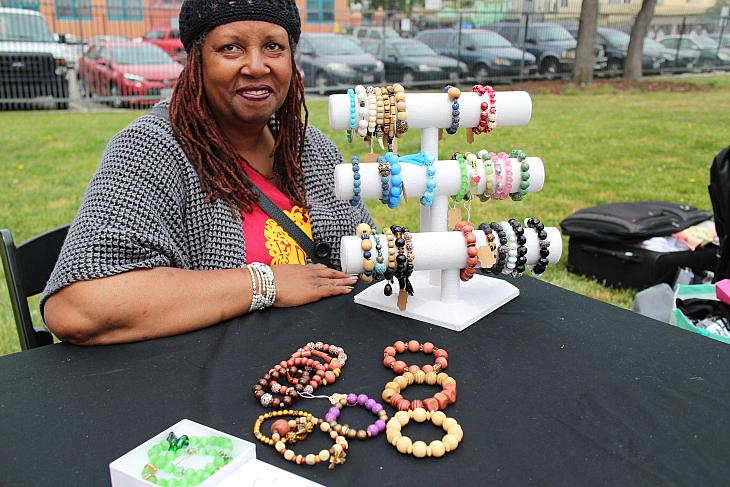
Angela Louie Howard, executive director of the Lotus Bloom Family Resource Center, runs the Bloom by Bloom center in Castlemont. The center provides early childhood education and parent support groups for low-income families. They also put on playtime events at the market.
"It's this opportunity for us to really flip the script and transform the outcomes of a community that has historically been so underserved and under-resourced and that no one has ever paid attention to," she said.
Ultimately, she believes the infant mortality rates that have driven the work may be just a small piece of the bigger puzzle affecting African American lives.
"As we continue to uncover," Louie Howard said, "we're gonna see more and there's going to be a lot more work to be done."
Has the BBZ program moved the needle since it started six years ago? Overall, the percentage of premature births in Alameda County has not changed since 2000. Castlemont makes up just a small area which sees about 90 births a year, so local health experts say its hard to measure. And, at this point, they say it may not be the right question to ask.
"We haven't been at it long enough see whether it's having an impact in this particular arena," said Kiko Malin, Family Health Services division director with Alameda's Department of Public Health.
Infant mortality disparities have "been centuries in the making," said researcher Tyan Parker Dominguez. "So it's not something that's going to be undone overnight."
People who live in Castlemont say they do feel a change. As playtimes gain in popularity, families gather more often. Parents who used to volunteer at the early childhood center are now employed there.
"There's a lot more opportunities here," said Stacey Mathews, an early childhood educator at the family resource center. "I see a lot more families playing with children. I see more young adults accessing opportunities, less crime."
But there's a long way to go. The main street that runs through Castlemont is still lined with vacant shops peppered between a handful of churches. As rising housing costs push families out of the Bay Area, many residents have moved away.
Alameda County officials say the work in Castlemont is part of a larger effort.
"Babies are our future," said Malin. "I mean, it sounds corny, but all of us were babies once and that's how, you know, you populate healthy communities with healthy adults who started out as healthy babies."
'DADS MATTER, TOO'
I haven't seen any billboards, any television commercials like the 'be all that you can be' Army commercial that I see on the television, bringing women into the health care system. It is a voluntary organization, you have volunteers who are doing what they can. We need leadership in this area, and a voluntary organization in an area this vital is not acceptable. - Angela Glover Blackwell, counsel, Public Advocates, Inc., 1984
"What's wrong with this crib?" Stacy Scott asks a group of men sitting on folding chairs in the center of a community center in Toledo, Ohio.
They examine the photo projected on a screen and call out different issues. The baby is face down, there are stuffed animals and a big pillow in there.
"Everything that could be wrong is wrong," said Scott.
Members of the Toledo chapter of Kappa Alpha Psi during a presentation on infant mortality rates and safe sleep practices. (Priska Neely/KPCC)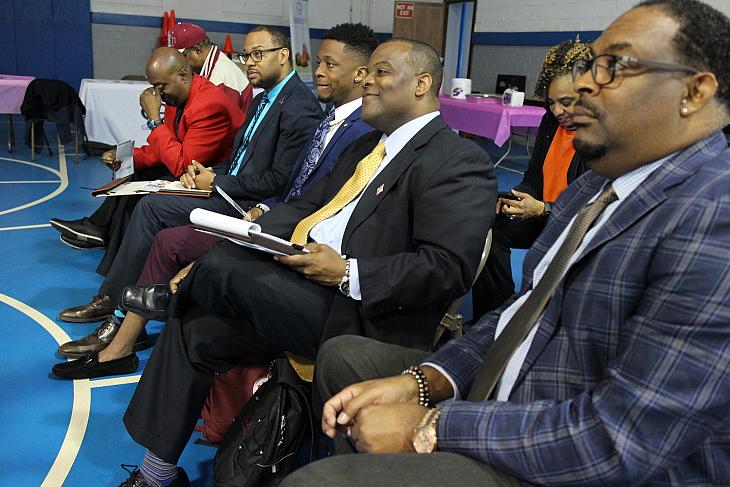
On this rainy Saturday in May, six members of Kappa Alpha Psi, a black fraternity, are learning the best practices to keep a baby safe while sleeping.
"You got blankets in there as well?" one member asked.
"No blankets," Scott said sternly, sensing some skepticism at this notion. "Just a plain old crib, the mattress, a tight-fitted sheet. No bumper pads, no pillows."
Ohio has some of the highest infant mortality rates in the country and the rate for black babies (15.2) is nearly three times higher than for white babies (5.8). While the primary cause is prematurity and low birthweight, there is also a gap in SIDS -- Sudden Infant Death Syndrome. SIDS rates are two times higher for black babies than white babies.
That's in part because of an information gap for black parents. So this is where Scott has decided to focus.
"We could talk about racism, we can talk about housing, we can talk about a lack of employment -- a lot these things are systematic and policy driven." said Scott.
But "if I'm an African American parent who has just brought my baby home and I'm just trying to be the best parent I can be, the one thing I can do as a parent is to keep my baby safe by following these instructions."
Scott spent 17 years working on safe sleep campaigns at the federal level with the Eunice Kennedy Shriver National Institute of Child Health. Those campaigns led to a massive decline in SIDS, but that message didn't always reach African-American families.
Two years ago, Scott founded the Global Infant Safe Sleep Center to tackle that head-on. They launched an initiative called "Changing A Tradition, Changing A Position," to make sure the 2.7 million grandparents raising children have the latest information that sleeping on the back is best.
And, through the partnership with Kappa Alpha Psi, she's working to fill another gap.
After Stacy Scott gave a presentation about safe sleep during a church service at Family Baptist Church in Toledo, this dad approached her for more information. (Priska Neely/KPCC)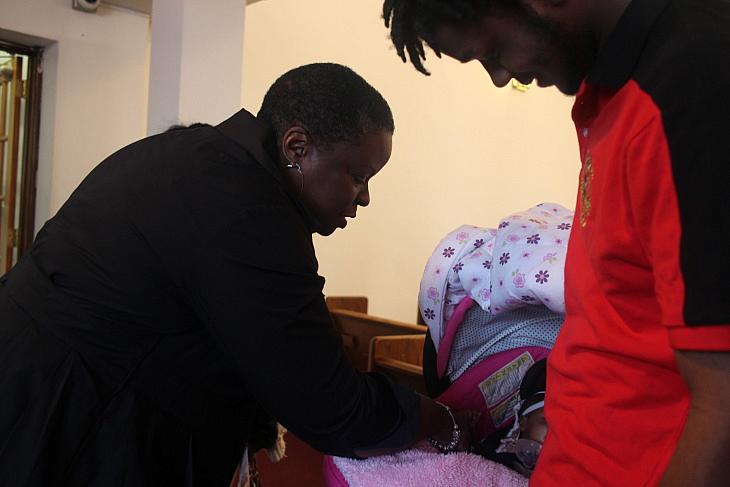
"We always worked with moms and babes, but my vision, I always thought it would be great to be able to bring the dad into the conversation."
Kappa Alpha Psi has adopted safe sleep as one of its national initiatives.
"If we save one life in this country it's worth it," said Dr. Edward Scott II, the national health and wellness chair for the fraternity.
More than 5,000 men across the country -- undergraduates, alumni, elders -- have completed training in safe sleep practices. Stacy Scott weaves in the research about the impact of structural and institutional racism and chronic stress into her presentations and tells the men they can make a difference by being a present, positive force to shield stress.
"It's one thing coming from me, but you all are able to tell other men about the impact that they have is just so much better," she tells the group.
"This has spurred me to want to do that more and be more aggressive and going out and trying to reach those black men," said Steven Powell, leads the Toledo Alumni Chapter of Kappa Alpha Psi.
"I don't have any children," said 21-year-old Adam Willis, a student at University of Toledo. "When I do decide to have children, whenever that may be, I'll be well informed of what to do."
Chapters across the country are adding unique twists to how they spread the message.
Scott says the point of the movement is: "Dads do matter too."
As an African-American woman from the same community, she's careful about framing the message. The focus is on conversation, not lectures.
"It's not a blaming. 'You can't afford a crib, so you're a bad mom.' It's more of -- 'Do you have a crib? What can we do to help you get one?'" said Scott.
Now that researchers and health experts better understand the underlying problem, Scott says: "The issue is the work you do to correct these ills of our society that have existed hundreds of years. How do you do that?"
Ohio has made combating infant mortality a top priority in the state budget. Officials have recently invested millions into efforts to reduce the racial gap as part of a state health improvement plan. So far, public health departments have focused on enhanced maternal services and safe sleep.
"People are uncomfortable talking about the racism piece, but it's there and it's real and until we talk about it, we're going to keep having the same outcomes," said Celeste Smith, minority and community health supervisor at Toledo Lucas County Health Department.
"I get told all the time, 'You're making this a black-white thing,' and I say 'Hold up, Celeste is not making it black and white thing, the data is making this a black and white issue.' "
The data is straightforward. The fix is complicated.
WHY THE GAP PERSISTS
We should not have to wait for any more studies or any more data to appear before this committee and Congress to shock this Nation. ... I think we have to reverse the current priorities in budget policies of this administration and ensure that each new life in this country is given an opportunity to be a healthy one. - Alan Sanders, Woman, Infants and Children (WIC) program specialist for the Food Research and Action Center, 1984
In Los Angeles County, the health department is not shying away from the conversation about racism.
Source: L.A. County Department of Public Health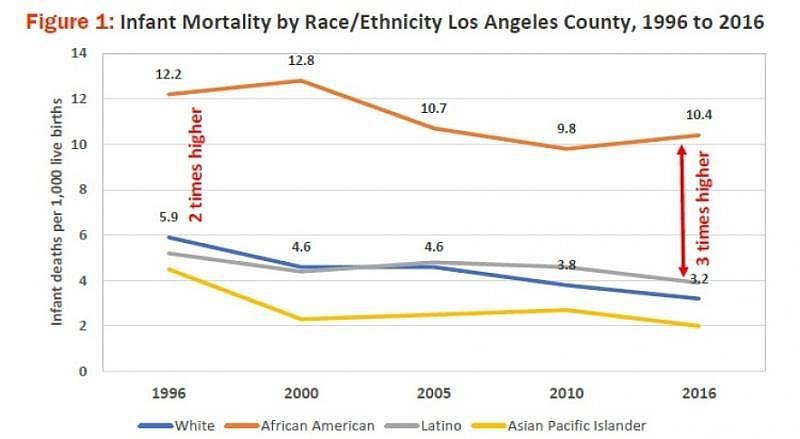
"The legacy of past and ongoing systemic racism in the United States contributes to persistent gaps observed in infant mortality," reads a line in a two-page fact sheet from the county about the issue.
As the research about the role of racism is re-confirmed and more widely disseminated, the head of the department believes that past failure to recognize it has been the missing piece.
"You really can't talk about dismantling racism, without talking about dismantling white privilege," said Dr. Barbara Ferrer, head of the Los Angeles County department of public health.
"And people in power, which are primarily in the United States people who are white, are threatened by those conversations."
The county launched a five-year action plan in the spring aimed at closing the black-white gap by 30 percent. To reach that goal, county officials have married the fight against infant mortality and the fight against racism.
Ferrer, who is Puerto Rican, came to Los Angeles in 2017. She spent decades working in public health in Massachusetts. Under her leadership, Boston saw significant declines in infant mortality.
In the 1990s, she recalls that officials in Boston got pushback when dollars were designated to specifically address black infant mortality. But she said that's what needed to happen.
"For years, we've been saying, just do good things, lift up all boats, and everyone will enjoy good outcomes," said Ferrer. "None of that was addressing the root cause of the lack of opportunities, the lack of economic security, the devastation of families with the racist criminal justice system that disproportionately was putting men of color into jails and prisons, and totally destroying families and communities."
She believes closing the gap means building on tangible steps like prenatal care and safe sleep messaging -- not to mention efforts to increase access to safe and affordable housing and to provide training to make county employees aware of unconscious prejudices.
Putting significant resources into fighting the problem is something authorities say is necessary, but lamentable.
"Should this be an enviable place for someone to be in? No, this is about the loss of life," said Yolonda Rogers, Los Angeles County coordinator for the Black Infant Health program.
In the nearly 30 years since Black Infant Health was established, the chronically underfunded program has served tens of thousands of women, but has only made a small dent in the gap. The program underwent a restructuring a few years ago and some participants are frustrated that they now are reaching a tiny fraction of the people they used to serve.
Los Angeles County wants to expand the reach of programs like Black Infant Health. County officials also say they want to mitigate the stressors that black women face. It's not clear how much money officials in L.A. County will allocate to try to meet the goal, but Ferrer said the issue is her top priority.
The Black Infant Health program got some good news in the latest California budget. Sen. Holly Mitchell, who chairs the budget committee, secured an additional $8 million for the program -- doubling the current funds available for the 15 counties that administer it.
Mitchell says issues of race often prompt eyerolls from the public and public officials.
"For some, it feels so big and so overwhelming, it's like, 'I can't begin to solve that issue,'" she said. "For others, there's just fundamental disbelief. There's a disbelief that explicit and implicit bias can have a direct impact on a person's ability to live, survive and be healthy in this country."
Setting that aside, Mitchell says she believes the funding she's backed may ultimately save money.
A preterm birth costs an employer 12 times as much as an uncomplicated birth -- upwards of $54,000 compared to $4,389, according to analysis by March of Dimes.
"We're looking at, not only the human element, of not addressing a huge, glaring disparity, but let's talk about the public cost to the hospitalizations and the long-term medical care for preterm infants. It's huge," said Mitchell. "So if we can invest on the front end, preventive dollars to help improve birth outcomes, why wouldn't we?"
'ALLIES IN ALL CORNERS'
I stand at the bedsides of these mothers, some white, many Latin, but mostly black, at the bedside of these mothers whose babies are dying, and when I know it can be prevented, I don't want to hear about task forces. - Dr. Vicki Alexander, 1984
Raena Granberry is happy to hear this straight talk from lawmakers and public officials. She's cautiously optimistic that all the meetings and task forces in recent months could lead to real change.
"But sometimes," she said, "it just feels like conversation. It's a whole lot of convenings -- we convene to death."
Ferrer said she agrees.
"We're not going to convene ourselves to changing this," she said. "We're going to have to do some things to change this."
Not just black moms. Not just doctors. Not just public health officials. All of us.
One of the last interviews that I did for this story was with Dr. Vicki Alexander, the doctor who testified at that hearing all those years ago. The now-retired obstetrician and gynecologist runs a Bay-Area nonprofit called Healthy Black Families. She's dedicated her life to trying to save black babies -- to closing that gap that still has black babies nationwide twice as likely as white babies to die before their first birthday.
"That figure -- that 2:1 -- is still nagging at us," she said.
She told me what an uphill battle it's been. She told me about fighting for attention, funding and policy change.
Hearing her experiences, which mirror and echo those of dozens of others I interviewed, was like a heavy weight. I sighed loudly as we talked on the phone.
"I hear you sighing, but don't sigh, it's OK!" Alexander reassured me with a warm and buoyant laugh.
"It just tells you, it's going to be protracted and you have to have allies in all corners."
[This story was originally published by laist.]

